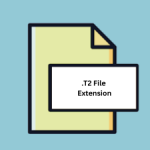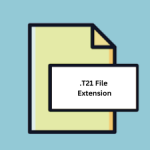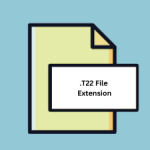.ENW File Extension

EndNote Import File
| Developer | Clarivate |
| Popularity | |
| Category | Data Files |
| Format | .ENW |
| Cross Platform | Update Soon |
What is an ENW file?
.ENW files are associated with EndNote, a reference management software developed by Clarivate Analytics.
These files serve as a means to import references, citations, and bibliographic data into the EndNote software environment.
EndNote offers a comprehensive platform for organizing references, generating bibliographies, and collaborating with peers, making it a staple tool in academic and research settings.
More Information.
The inception of .ENW files aligned with the growing need for researchers to organize vast amounts of bibliographic data efficiently.
EndNote aimed to streamline this process by providing a centralized platform where users could store, manage, and cite references seamlessly.
The .ENW file format was designed to facilitate the importation of bibliographic information from various sources into the EndNote library, thereby enhancing the software’s utility for users across diverse disciplines.
Origin Of This File.
The .ENW file extension emerged alongside the development of EndNote, which traces its roots back to the late 1980s. Initially created by Niles and Associates, EndNote has undergone several iterations and enhancements over the years.
With the evolution of digital research practices, the .ENW file became a crucial component for efficiently managing references within the EndNote ecosystem.
File Structure Technical Specification.
.ENW files adhere to a structured format that encapsulates bibliographic metadata in a standardized manner.
Typically, these files contain information such as author names, publication titles, journal names, publication dates, and other relevant citation details.
The structure of .ENW files are often based on recognized citation styles and standards, ensuring compatibility with different referencing systems.
Technically, .ENW files may utilize formats like XML (Extensible Markup Language) or proprietary formats specific to EndNote.
The data within these files are organized hierarchically, with tags or fields delineating different components of the bibliographic entries.
This structured approach enables EndNote to parse and display the imported information accurately within its interface.
How to Convert the File?
Converting .ENW files to alternative formats can be crucial for compatibility, interoperability, and sharing purposes. Here’s a detailed guide on how to convert .ENW files:
Exporting from EndNote:
- Open EndNote software on your computer.
- Navigate to the library containing the references you wish to export.
- Select the references you want to export by clicking on them or using the “Edit” menu to choose “Select All” if you want to export all references.
- Go to the “File” menu and choose “Export”.
- In the export dialog box, select the desired output format. Common formats include BibTeX (.BIB), RIS, or plain text (.TXT).
- Choose a location on your computer to save the exported file, and give it a descriptive name.
- Click “Save” to initiate the export process.
Using Conversion Tools:
- If you need to convert .ENW files to formats not directly supported by EndNote’s export options, you can utilize third-party conversion tools or online converters.
- Search for reputable conversion tools or websites that support the conversion of .ENW files to your desired format.
- Upload the .ENW file to the conversion tool or website.
- Select the output format you wish to convert the file into.
- Follow the on-screen instructions to complete the conversion process.
- Once the conversion is finished, download the converted file to your computer.
Using Reference Management Software:
- Some reference management software, such as Zotero and Mendeley, offer import functionalities that support .ENW files.
- Open the reference management software on your computer.
- Locate the option to import references or files.
- Choose the .ENW file you wish to convert and import.
- Follow the prompts to complete the import process.
- Once imported, you may have the option to export the references in various formats supported by the software.
Scripting and Automation:
- For advanced users or those with programming skills, scripting, and automation can provide efficient ways to convert .ENW files in bulk.
- Write or find scripts or programs that can parse .ENW files and convert them to your desired format.
- Customize the script to meet your specific requirements, such as handling special characters or formatting issues.
- Execute the script or program, providing the .ENW files as input, and let it perform the conversion automatically.
By following these methods, you can convert .ENW files to alternative formats, enabling compatibility with various reference management systems, document editors, and collaboration platforms.
Advantages And Disadvantages.
The adoption of .ENW files offer several advantages to users engaged in academic or research activities. Firstly, these files enable seamless integration with EndNote, allowing users to populate their libraries with references from various sources effortlessly.
Additionally, .ENW files preserve the integrity of bibliographic data during importation, minimizing errors and discrepancies in citation formatting.
Like any file format, .ENW files also have certain limitations and drawbacks. One notable disadvantage is the proprietary nature of EndNote, which may pose challenges for interoperability with other reference management systems.
Users who wish to migrate their bibliographic libraries to alternative platforms may encounter difficulties due to compatibility issues with .ENW files.
Reliance on a specific software solution like EndNote entails subscription costs and dependency on vendor support for updates and maintenance.
How to Open ENW?
Open In Windows
- EndNote: Install EndNote software for Windows from the official website or through a licensed copy. Once installed, double-click the .ENW file, and it should open in EndNote automatically.
- Third-party reference management software: Alternatively, you can use third-party software like Zotero or Mendeley, which offer Windows versions that support .ENW files. Install the software, import the .ENW file, and access the references within the program.
Open In Linux
- While EndNote doesn’t have a native version for Linux, you can explore compatibility options using virtualization software or compatibility layers like Wine. These methods may not offer seamless .ENW file support.
- Alternatively, open-source reference management software like Zotero or Mendeley may offer Linux versions with .ENW file support. Install the software using the package manager or download it from their respective websites.
Open In MAC
- EndNote: Similar to Windows, download and install EndNote for macOS. Double-click the .ENW file, and it should open in EndNote.
- Third-party software: Zotero and Mendeley also offer macOS versions that support .ENW files. Install the software, import the .ENW file, and access the references within the program.













